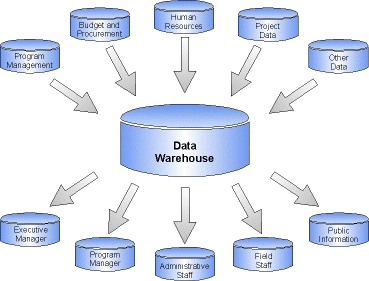Benefits of Data warehouse
In computing, a data warehouse (DW or DWH), also known as an enterprise data warehouse (EDW), is a system used for reporting anddata analysis. DWs are central repositories of integrated data from one or more disparate sources. They store current and historical data and are used for creating trending reports for senior management reporting such as annual and quarterly comparisons.
The data stored in the warehouse is uploaded from the operational systems (such as marketing, sales, etc., shown in the figure to the right). The data may pass through an operational data store for additional operations before it is used in the DW for reporting.
Types of systems
A data mart is a simple form of a data warehouse that is focused on a single subject (or functional area), such as sales, finance or marketing. Data marts are often built and controlled by a single department within an organization. Given their single-subject focus, data marts usually draw data from only a few sources. The sources could be internal operational systems, a central data warehouse, or external data
Online analytical processing (OLAP)
Is characterized by a relatively low volume of transactions. Queries are often very complex and involve aggregations. For OLAP systems, response time is an effectiveness measure. OLAP applications are widely used by Data Mining techniques. OLAP databases store aggregated, historical data in multi-dimensional schemas (usually star schemas). OLAP systems typically have data latency of a few hours, as opposed to data marts, where latency is expected to be closer to one day.
Online Transaction Processing (OLTP)
Is characterized by a large number of short on-line transactions (INSERT, UPDATE, DELETE). OLTP systems emphasize very fast query processing and maintaining data integrity in multi-access environments. For OLTP systems, effectiveness is measured by the number of transactions per second. OLTP databases contain detailed and current data. The schema used to store transactional databases is the entity model (usually 3NF)
Predictive analysis
Predictive analysis is about finding and quantifying hidden patterns in the data using complex mathematical models that can be used to predict future outcomes. Predictive analysis is different from OLAP in that OLAP focuses on historical data analysis and is reactive in nature, while predictive analysis focuses on the future. These systems are also used for CRM (Customer Relationship Management).
Benefits
A data warehouse maintains a copy of information from the source transaction systems. This architectural complexity provides the opportunity to :
- Congregate data from multiple sources into a single database so a single query engine can be used to present data.
- Maintain data history, even if the source transaction systems do not.
- Improve data quality, by providing consistent codes and descriptions, flagging or even fixing bad data.
- Present the organization’s information consistently.
- Provide a single common data model for all data of interest regardless of the data’s source.
- Make decision–support queries easier to write.




